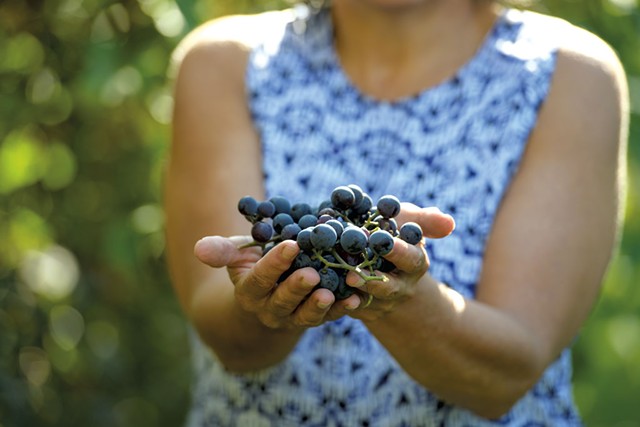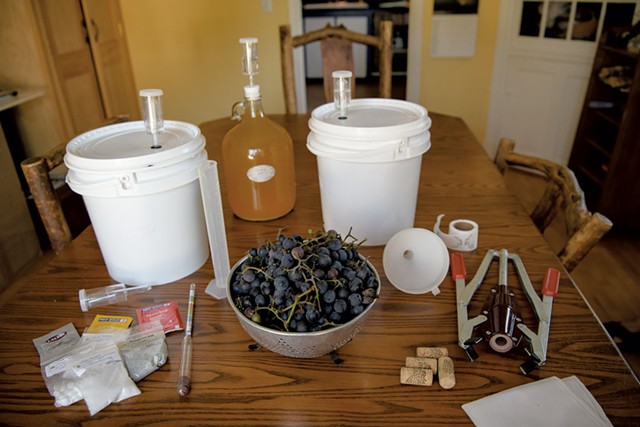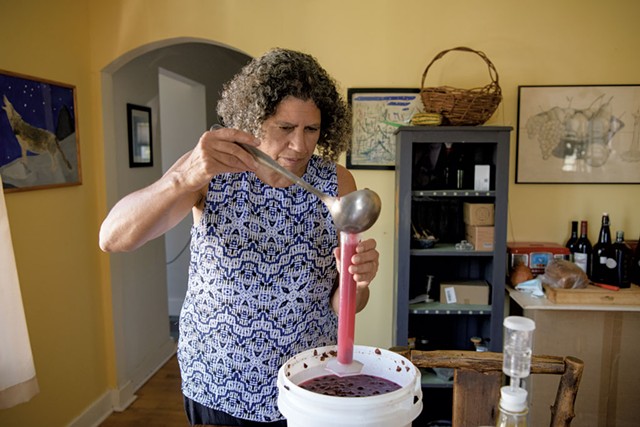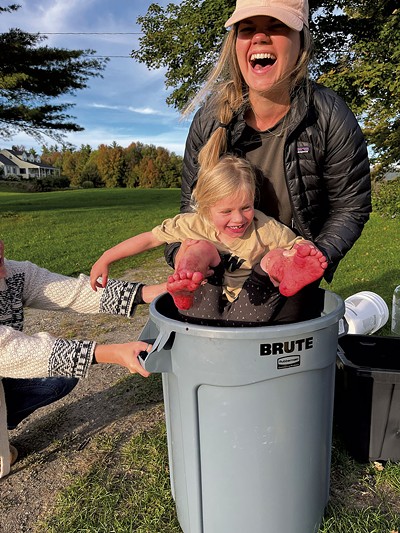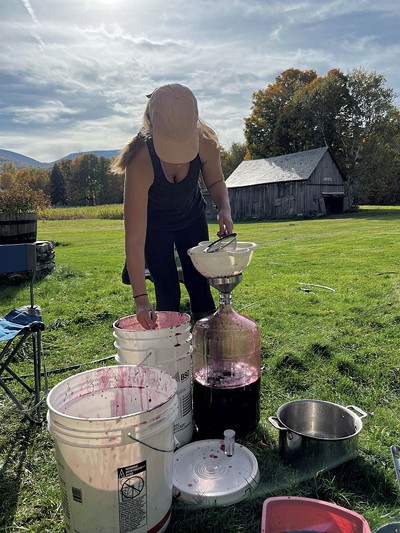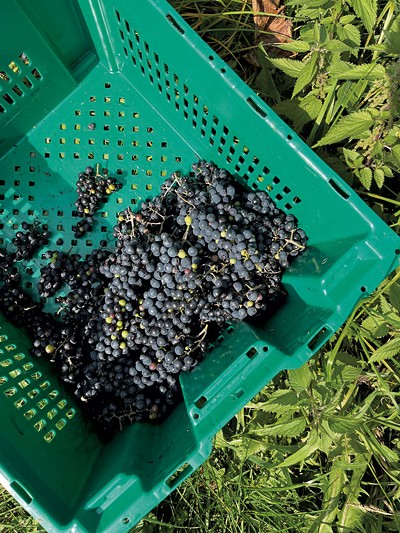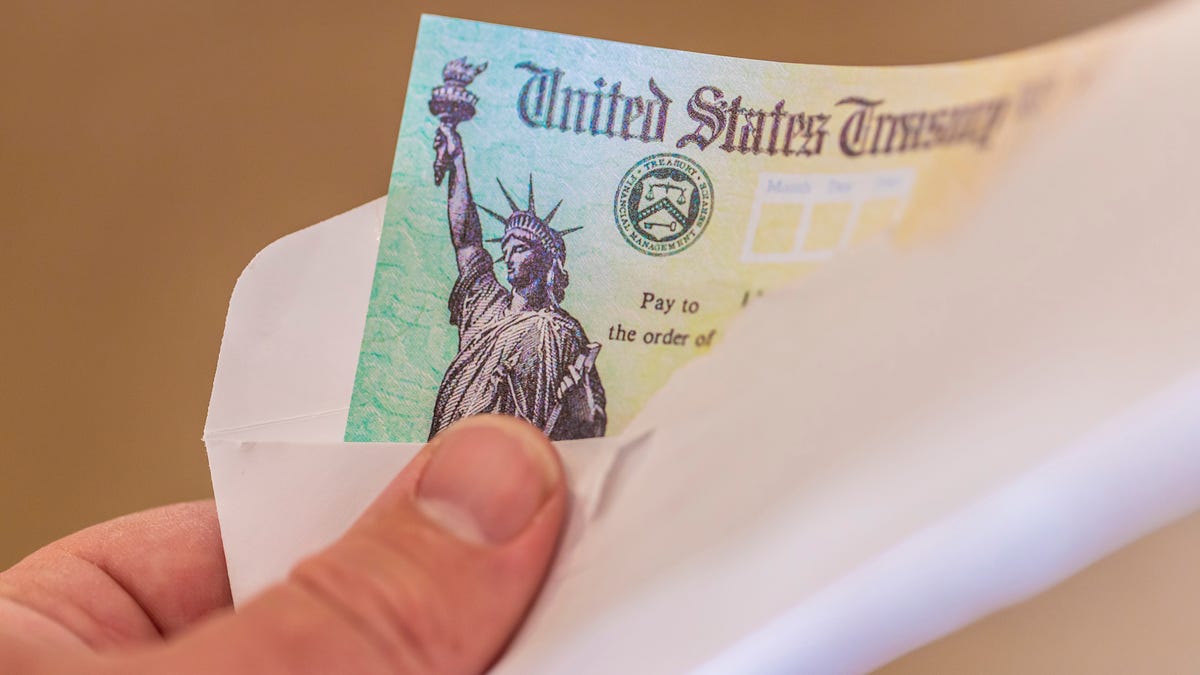Vermont
As Vermont’s Wine Industry Grows, Home Winemakers Are Inspired to DIY
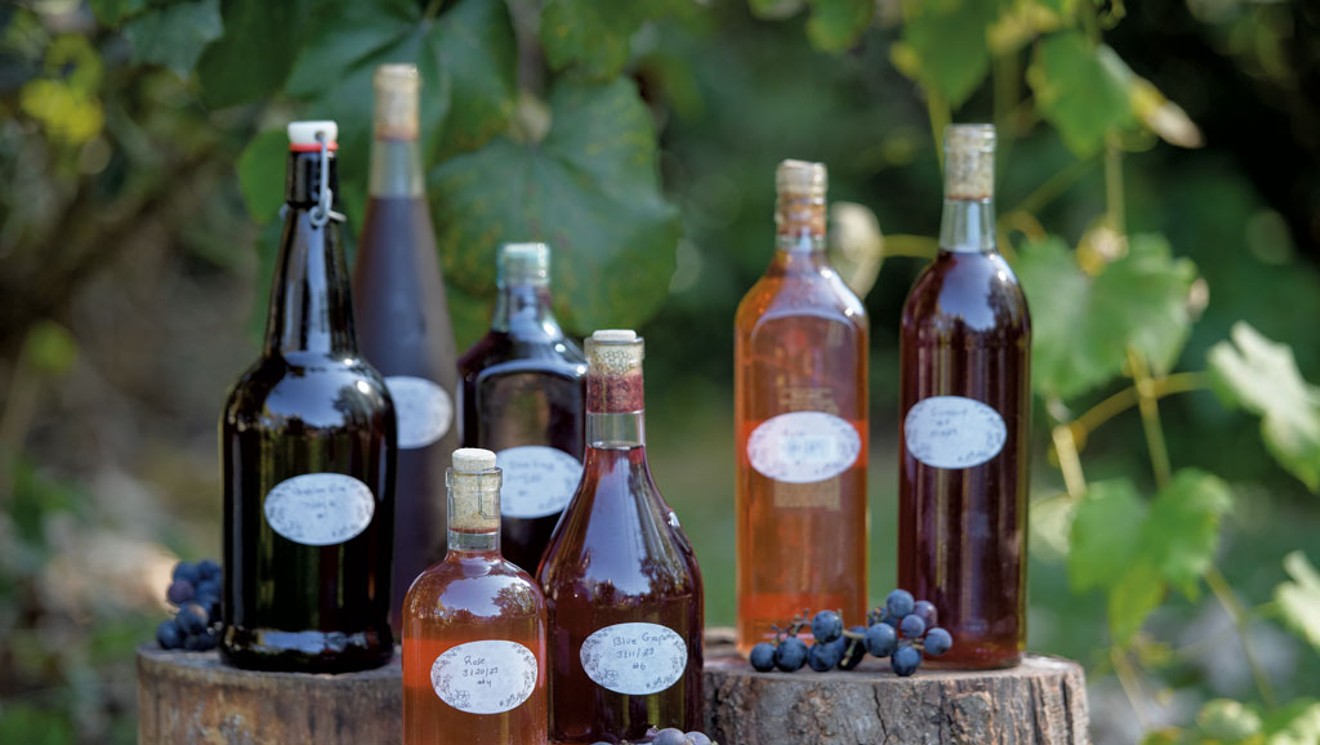
For much of human history, wine has had a place on the dinner table. At Jessica Wagener’s house in Burlington’s New North End, the wine on the table just happens to be still fermenting away in three-gallon plastic buckets.
Beer brewing and annual autumn cider presses have dominated the home booze production scene for years, but Wagener is one of an increasing number of Vermonters who are taking a DIY approach to making wine from grapes. Some, such as Wagener, are using grapes that happen to grow in their backyards. Others, inspired by the state’s growing commercial wine scene, are purchasing cold-hardy hybrid grapes or planting them in small-scale vineyards. Wherever the fruit comes from, home winemaking is easier than it sounds.
When Wagener and her husband, Alan, bought their home 25 years ago, it came with grapes. The couple haven’t officially identified the three varieties that grow over arbors in their backyard, which Alan protects from hungry, savvy raccoons with electric fencing. But one seems to be a classic Concord, Wagener said; the others are an unknown red variety and one they call “blue grapes.”
For about five years, Wagener has made separate wines from each variety. She smashes the grapes by hand; adds some water and sugar or honey; checks the wine’s specific gravity using a hydrometer; adds pectic enzyme, yeast nutrient and yeast; and then leaves the buckets alone on the kitchen table for a week. After that first fermentation stretch, she strains out the grapes and ages the juice in glass carboys in the basement. Each two-gallon batch yields six or seven bottles.
As involved as that process sounds, Wagener was quick to say it isn’t intimidating. To get started, she googled recipes and asked questions at Vermont Homebrew Supply in Winooski. The most expensive piece of equipment she bought for winemaking is a bottle corker, available for less than $30. The bulk of the work is sanitizing and keeping things clean.
“It’s really a very accessible thing, because foods naturally want to ferment,” Wagener said. “It’s very homegrown, what we do.”
The final product can be an acquired taste, she added with a laugh: “It has a homemade flavor, but people say they like it. They drink it, anyway.”
Thanks to a relatively recent expansion in vineyard plantings around the state, Vermont Homebrew Supply co-owner Anne Whyte is seeing more home winemakers giving grapes a go, she said. Most use hybrid varieties, which yield a final product similar to the Vitis vinifera grapes that dominate the wine industry. The hybrids’ later bud dates and quicker maturation are well suited to our short growing season — even a challenging one like this year’s.
Whyte recalled a visit with Shelburne Vineyard cofounder Ken Albert, who came into the shop when he was still a home winemaker, before planting his first commercial vines in 1998.
“Ken taught me about the hybrid grapes, which have revolutionized Vermont winemaking,” she said. “That trickles down to home winemakers and growers. There’s a classic homebrewer attitude: If somebody else in Vermont can do it, I can, too.”
Whichever fruit a home winemaker uses, Whyte said, their equipment need not be fancy. Small upgrades such as siphoning equipment and air locks — which vent the gas that yeast produces during fermentation while keeping out pesky fruit flies — differentiate today’s winemakers from their medieval predecessors. To make a gallon batch, the startup equipment costs, not including fruit, can be as little as $36. For another $10, customers can purchase the yeasts and additives they want to include, if any.
Current trends in the wine industry — especially among low-intervention natural winemakers — are things home winemakers have done for ages, Whyte said.
“It’s much like craft beer, which is here because of homebrewers who wanted different beers than Bud, Molson and Miller,” she said. “Or craft cider, which is here because people didn’t want mass-produced, sweet ciders. Using wild yeast, cofermenting, not filtering — we’ve been doing that forever.”
Paola Canty is taking that low-intervention approach to her home winemaking, inspired by Vermont natural wine pioneer Deirdre Heekin of La Garagista Farm + Winery.
“I was getting anxious about the process,” Canty said. “Then I realized that people have been making wine for thousands of years. It can’t be too hard if people have been doing it for so long.”
Canty has been surrounded by wine since her youth in New York City; her mom, a salesperson for a wine importer, would often bring home leftover samples. When Canty went to college, her bedroom immediately turned into wine storage. She and her husband moved to Danby from Brooklyn two years ago; as they tried to figure out what to do with their new plot of land, she saw an Instagram ad for VT Vineyards, a company that installs small-scale vineyards all over the state.
After talking with VT Vineyards founder Stephen Wilson, the couple decided to have him plant eight rows of hybrid grapes in their backyard in the spring: 80 marquette, 40 frontenac gris and 40 Louise Swenson.
It will take up to five years for those vines to bear a full harvest. In the meantime, Canty has started practicing her winemaking skills. Last year, she purchased a winemaking equipment kit and 100 pounds of petite pearl grapes from Wilson; this year, she purchased 100 pounds of marquette. Her first five-gallon vintage was “barely drinkable but not vinegar,” she said.
“I have no experience in winemaking at all,” Canty said. “The plan is to mess up with the grapes we buy. That way, the grapes we’ve spent five years growing — we can actually do something with them.”
Like Wagener, Canty takes a straightforward approach. Both years, she stomped the grapes in a plastic garbage can with help from her now 4-year-old daughter. This year’s batch is currently in the middle of its first fermentation, stored in a bedroom next to her Peloton. Because the process takes several months, she’s been researching one step at a time.
“It’s not something you have to figure out all at once,” Canty said.
Taking a harvest break at Maquam Barn & Winery in Milton on a late September day, Wilson of VT Vineyards said curious home winemakers such as Canty make up most of the owners of the nearly 40 vineyards he’s installed over the past three years. Most share the homebrewers’ philosophy that Whyte pointed out.
“They’ve had something from Shelburne Vineyard or La Garagista or Ellison Estate, and they’re like, ‘This is awesome. They’re making this with Vermont grapes; maybe I can, too,’” Wilson said.
It’s not the cheapest hobby if you have to purchase fruit, he admitted, estimating that 100 pounds of fruit and the necessary equipment for that first five-gallon batch run around $500.
“But when you crack a bottle you made yourself, it’s super worth it,” Wilson said. “It’s such a fun feeling.”
Access to grapes can be a barrier for home winemakers who don’t have vines in their backyards or whose vineyards aren’t producing full crops yet. The state’s industry is still growing, and when setbacks such as this spring’s late frost hit, the fruit can be scarce. Still, Wilson urged, there’s a lot to be learned from stopping at a tasting room and talking with the winemakers or volunteering during harvest.
Wilson dabbles in winemaking himself, though he prefers to leave technical questions to the pros. His home vineyard in Underhill is a “mishmash” of varieties, he said, with 200 plants sourced from Andy and India Farmer at Northeastern Vine Supply in West Pawlet.
VT Vineyards sells fruit from the half dozen maintenance projects that Wilson and employee Reuben Jalbert have taken on, including Maquam, which is one of the largest commercial vineyards in the state. There’s still a bit of marquette left to be sold this year, though most of their harvest from vineyards in Waitsfield, Swanton, Castleton, Hinesburg, Stowe and Milton is already destined for winemakers in Vermont and New Hampshire.
“The commercial winemakers need the fruit, but I think there’s enough to get it into hobbyists’ hands,” Wilson said. “If the winemakers miss out on a few pounds of grapes, it’s being made up for when people make wine themselves, share it with friends and family, and get them excited about Vermont wine.”
Wagener is doing her best to set aside a few of the six or seven bottles she gets from each batch of wine to age. That takes discipline, she said, because there’s nothing more satisfying than setting homemade wine back on the table — this time in a bottle, ready to share.

Vermont
9-year-old drowns in Vermont lake

BURLINGTON, Vt. (WCAX) – Vermont Green FC is headed to the USL2 Sweet 16 after a 3-1 win over the Long Island Rough Riders in Ocean City, New Jersey, and fans in Burlington got to watch it in a group.
Vivid Coffee serves as one of the club’s sponsors and hosted Friday afternoon’s event where supporters watched the livestream of Jacob Labovitz’s hat trick in the Green’s win.
It was a great chance for fans to share in the atmosphere even though they were 400 miles away.
“It’s the best place to be if you can’t make it down to the match,” said Mike Popovitch, a member of the Green Mountain Bhoys supporters group. “I think that fact that Ian (Bailey, owner of Vivid) does this and Vivd Coffee does this for us is pretty amazing. It brings the community together. Being able to watch an event from a team that really has brought the entire Burlington community together.”
The Green will play again Sunday evening, taking on Northeast Division rival Seacoast United.
Vermont
What happens to the Vermont ballots if Biden steps aside? Can another Democrat get on
Biden calls out Trump for golfing while he campaigns across US
President Joe Biden resiliently said he would not step down as president and said he can do the job.
Rumors are circulating that President Joe Biden may bow out of the 2024 presidential race this weekend — three weeks after a disastrous debate performance sewed doubt in supporters’ minds about his mental fitness.
But how would a last-minute dip from Biden impact the Nov. 5 general ballot in Vermont? At this juncture, it wouldn’t, said Chief of Staff Bryan Mills of the Vermont Secretary of State’s office.
Mills explained that his office traditionally does not print general election ballots until after the Democratic National Convention in mid-August, which means Biden’s theoretical replacement could easily make the cut should the president step aside before then.
Each state sets its own deadlines for candidates and the printing of ballots.
Several states have said that by the time the DNC occurs, the deadline to file to appear on the ballot in those states will have already passed. Because of this, Democrats may have to participate in an early roll call vote to determine their nominee before Aug. 22, the last day of the convention.
Biden’s replacement: Who would it be and how would they be chosen?
So far, Vice President Kamala Harris has received the warmest reception from political allies as a potential replacement for Biden on the Democratic ticket.
But how might Harris — or someone else for that matter — make it on the ballot if each state has already held its presidential primary?
If Democrats do not pursue an early roll call, delegates will need to select Biden’s successor at the DNC.
How smoothly the convention’s voting goes is highly dependent on whether Biden chooses to endorse a replacement. While convention delegates are not legally required to vote for Biden’s pick, they are inclined to do so, according to Forbes. On the other hand, should Biden fail to endorse someone — which would lead to a rare open convention — the DNC may become divided over multiple different candidates, throwing the party’s unity into question.
Megan Stewart is a government accountability reporter for the Burlington Free Press. Contact her at mstewartyounger@gannett.com.
Vermont
Westfield Babe Ruth 13-Year-Olds turn back St. Johnsbury (Vermont), 8-2, in N.E. regional opener

WESTFIELD – The Westfield Babe Ruth 13-Year-Old All-Stars had the right mix of ingredients (speed, timely hitting, a pair of strong arms) for an 8-2 win over St. Johnsbury (Vermont) on opening night of the Northeast Regionals Friday night at Bullens Field.
Westfield starting pitcher Jaylen Dean scattered five hits and two runs over 4 2/3 innings, striking out six batters; Jackson Barnes provided 2 1/3 innings of scoreless relief, allowing just one hit and two walks to go along with two K’s and one key pickoff.
-

 Politics1 week ago
Politics1 week agoWhat they're thinking: For many Democrats, silence speaks volumes on the Biden issue
-

 News1 week ago
News1 week agoHow Democrats Will Choose a Nominee
-

 World1 week ago
World1 week agoWill the NATO Washington summit deliver for Ukraine?
-

 News1 week ago
News1 week agoVideo: Biden ‘Is a Fighter,’ Harris Says in North Carolina
-

 Politics1 week ago
Politics1 week agoBiden's 'big boy' NATO news conference carries high stakes as first presser since disastrous debate
-

 Politics6 days ago
Politics6 days agoTwo key states to see massive GOP voter registration operation
-
News1 week ago
After a tragedy, a mother wants to soften the rooms where police interview victims
-

 World1 week ago
World1 week agoJapan, Germany agree to boost security cooperation in Pacific
